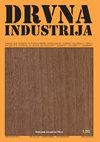Possibility of Use of NCC-Reinforced Melamine-Urea- Formaldehyde Adhesive in Plywood Manufacturing
IF 0.8
4区 农林科学
Q4 MATERIALS SCIENCE, PAPER & WOOD
引用次数: 1
Abstract
The possibility of using nanocellulose (NCC) as a filling substance for melamine-urea-formaldehyde (MUF) adhesive was investigated for the process of manufacturing plywood. The adhesive mixtures were prepared with various nanocellulose concentrations. The amount of introduced filler had a significant effect on both resin and plywood characteristics. Fourier transform infrared spectroscopy (FTIR) did not show any major changes between experimental and reference variants. The viscosity of resin increased after the introduction of nanocellulose. The addition of NCC in the amount of 5 g and 10 g per 100 g of solid resin led to an improvement in bonding quality, modulus of elasticity and bending strength. Further increase of NCC concentration caused a deterioration of manufactured plywood properties. In summary, the addition of proper amount of nanocellulose resulted in manufacturing plywood with improved properties.NCC增强三聚氰胺脲醛胶粘剂在胶合板生产中应用的可能性
研究了在胶合板生产过程中使用纳米纤维素(NCC)作为三聚氰胺-脲醛(MUF)胶粘剂填充物的可能性。用不同浓度的纳米纤维素制备粘合剂混合物。填料的引入量对树脂和胶合板的特性都有显著影响。傅立叶变换红外光谱(FTIR)在实验变体和参考变体之间没有显示出任何重大变化。引入纳米纤维素后,树脂的粘度增加。每100g固体树脂添加5g和10g的NCC导致结合质量、弹性模量和弯曲强度的改善。NCC浓度的进一步增加导致人造胶合板性能的恶化。总之,添加适量的纳米纤维素可以生产出性能得到改善的胶合板。
本文章由计算机程序翻译,如有差异,请以英文原文为准。
求助全文
约1分钟内获得全文
求助全文
来源期刊

Drvna Industrija
MATERIALS SCIENCE, PAPER & WOOD-
CiteScore
1.80
自引率
9.10%
发文量
32
审稿时长
>12 weeks
期刊介绍:
"Drvna industrija" ("Wood Industry") journal publishes original scientific and review papers, short notes, professional papers, conference papers, reports, professional information, bibliographical and survey articles and general notes relating to the forestry exploitation, biology, chemistry, physics and technology of wood, pulp and paper and wood components, including production, management and marketing aspects in the woodworking industry.
 求助内容:
求助内容: 应助结果提醒方式:
应助结果提醒方式:


